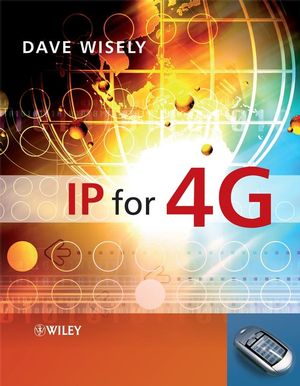IP for 4GISBN: 978-0-470-51016-2
Hardcover
314 pages
February 2009
 |
||||||
About the Author ix
Preface xi
Acknowledgements .xiii
List of Abbreviations xv
Chapter 1 Introduction 1
1.1 Prologue – The Generation Game 3
1.2 The Props – WLAN, WiMAX and All That 4
1.3 The Players – The Jester, the Harlequin and the Guy with the Beard and Sandals 7
1.4 The Plot – The Elephant in the Room 9
1.5 Epilogue – The Road to 4G 12
References 14
More to Explore14
Chapter 2 An Introduction to 3G Networks 15
2.1 Introduction 15
2.2 Mobile Standards 16
2.2.1 Who’s Who in Mobile Standards 16
2.3 The History of 3G 18
2.3.1 Pre-1996 – The Research Trimester 18
2.3.2 1996–1998 – The IMT 2000 Trimester 21
2.3.3 1998 Onwards – The Standardisation Trimester 23
2.3.4 3G Spectrum – the ‘‘Fuel’’ of Mobile Systems 23
2.4 UMTS Network Overview 27
2.5 UMTS Network Details 31
2.5.1 UMTS Architecture – Introducing the Major Network Elements and their Relationships 32
2.5.2 UMTS Security 34
2.5.3 UMTS Communication Management 37
2.5.3.1 Connection Management 37
2.5.3.2 Session Management 37
2.5.4 UMTS QoS 40
2.5.5 UMTS Mobility Management 43
2.5.6 UMTS Core Network Transport 44
2.5.7 Signalling in the UMTS Core Network 47
2.6 UMTS Radio Access Network (UTRAN) and Air Interface 48
2.6.1 The W-CDMA Air Interface and the Uu Interface 48
2.6.2 UTRAN Mobility Management 51
2.6.2.1 Soft Handover 51
2.6.2.2 Handover Types 52
2.6.3 UTRAN Transport 54
2.6.4 UTRAN QoS 55
2.6.5 UTRAN Signalling 57
2.7 CDMA2000 Packet Core Network 58
2.8 TD-SCDMA 61
2.9 Conclusion 62
References 62
More to Explore 63
Chapter 3 Wireless LANs 65
3.1 Introduction 65
3.2 Applications of WLANs 66
3.3 WLAN Compared to Cellular 70
3.4 How WLANs Work 72
3.4.1 MAC Layer 73
3.4.2 WLANs – History and the Physical (PHY) Layer and IEEE 802.11 Groups 81
3.5 Performance of WLANs 84
3.6 WLAN Network Coverage 86
3.7 Improving WLANs 88
3.8 Security 89
3.9 Roaming 93
3.10 Quality of Service (QoS) 95
3.11 Handover and Paging 101
3.12 Battery Life 104
3.13 Go Faster WLAN – 802.11n 105
3.14 Interference 107
3.15 Future of WLANs 110
References 113
More to Explore 113
Chapter 4 Cellular Evolution 115
4.1 Introduction 115
4.2 What is Wrong with 3G? 116
4.3 HSPA 120
4.3.1 HSDPA Basic Principles 120
4.3.2 Channels in HSDPA 125
4.3.3 Handover in HSDPA 128
4.3.4 QoS in HSDPA 128
4.3.5 Terminals, Capabilities and Enhancements 132
4.3.6 HSDPA Data Rates 133
4.4 HSUPA 136
4.5 EDGE 140
4.6 EVDO and CDMA2000 Evolution 143
4.7 Femtocells 145
4.8 LTE 150
4.9 Conclusion 157
References 157
More to Explore 159
Chapter 5 WiMAX 161
5.1 Introduction 161
5.2 Overview of WiMAX History 163
5.3 OFDM 165
5.4 WiMAX MAC Layer 173
5.4.1 Downlink QoS and Scheduling 174
5.4.2 Handover 176
5.4.3 Security in WiMAX 177
5.4.4 ARQ and Forward Error Coding 178
5.4.5 Idle Mode and Power Saving 179
5.5 WiMAX PHY Layer 180
5.6 WiMAX QoS 183
5.7 Spectrum 186
5.8 Smart Antennas 188
5.9 WiMAX Network Architecture 195
5.10 WiMAX Throughput and Performance 197
5.11 Conclusion 200
References 201
More to Explore 202
Chapter 6 Convergence and the IMS 203
6.1 Introduction 203
6.2 The IMS 204
6.2.1 User Registration 209
6.2.1.1 Attachment to the IMS 209
6.2.1.2 IMS-level Registration 212
6.2.2 Basic IMS Session Set Up 216
6.2.2.1 The INVITE Message 216
6.2.3 IMS QoS Authorisation 219
6.2.4 IMS Service Creation 221
6.2.4.1 The SIP Application Server (AS) 221
6.2.4.2 Other types of Application Server 223
6.2.5 Presence 225
6.2.6 Push to Talk Over Cellular (PoC) 226
6.2.7 Roaming and Breakout to PSTN 228
6.2.7.1 IMS Roaming 228
6.2.7.2 Breakout to the PSTN 229
6.3 Convergence Today – Fusion 231
6.4 Voice Call Continuity 234
6.5 Media Independent Handover 237
6.6 Next Generation Networks 243
6.7 The IMS in Context Today 249
References 251
More to Explore 252
Chapter 7 Mobile Services – The Final Chapter 255
7.1 Introduction 255
7.2 Beyond Voice and SMS 256
7.3 Hard Lessons – MMS and WAP 258
7.4 Innovation – Mobile Music 261
7.5 Broadcast Services 262
7.5.1 DVB-H – Digital Video Broadcast-Handheld 263
7.5.2 DAB-IP – Digital Audio Broadcast-IP 264
7.5.3 MBMS – Multimedia Broadcast and Multicast Services 264
7.6 A New Paradigm – 1000 Killer Applications 265
7.7 Terminals 267
7.8 Money Makes the World Go Around 269
7.9 Mobile Broadband 274
7.10 Conclusion 275
7.10.1 Domination by the Mobile Operators 276
7.10.2 Converged World 276
7.10.3 Internet Scenario 277
7.10.4 Final Conclusion 278
References 279
Index 281



